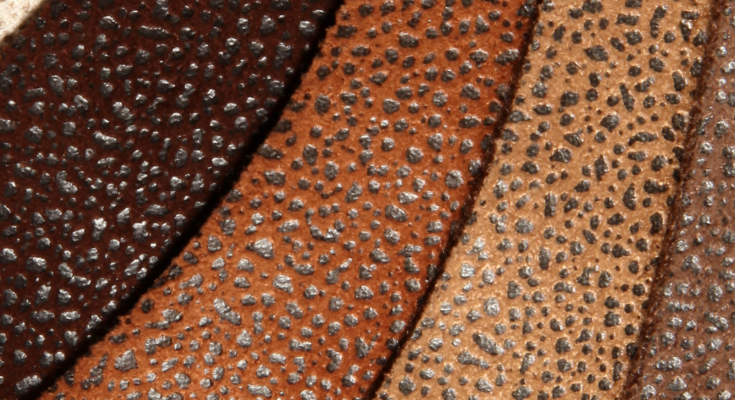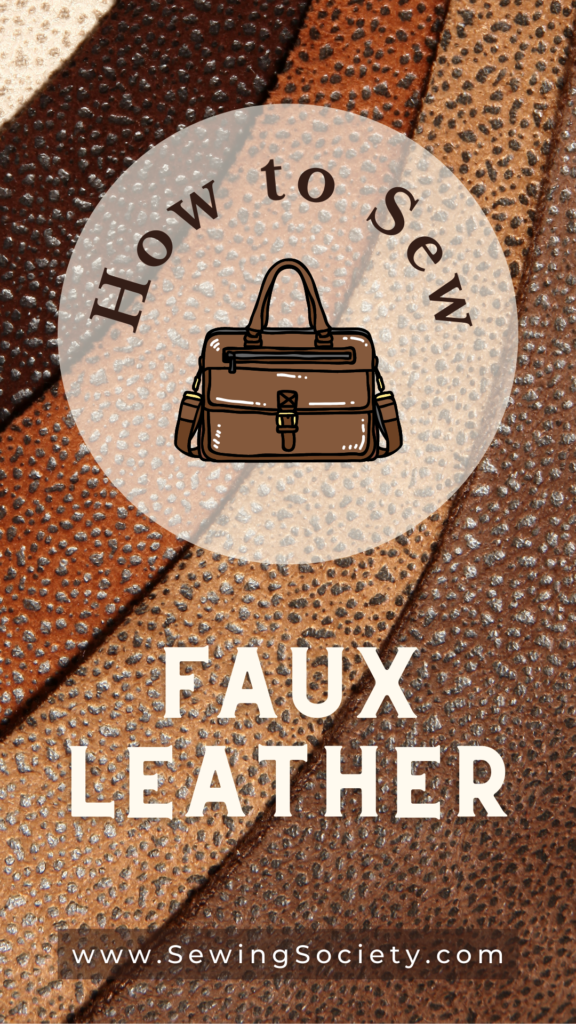Disclosure: This post may contain affiliate links. I earn a small commission when you click a link and make a purchase. Thanks for supporting SewingSociety.com!
Faux leather is used for all sorts of things, but bags and jackets are the first that come to my mind. I love sewing with faux leather. I like the look and durability. If you’ve never worked with faux leather before, I suggest you start with a simple bag pattern.
If you want to learn how to sew faux leather, it’s not as difficult as you think. And you don’t need to buy a special, heavy-duty sewing machine. You just need to learn a few tricks for working with this fabric. I hope this post gives you the confidence to sew faux leather like a pro.
Faux leather is made by bonding a plastic coating that mimics the look of leather to a fabric backing. There are two main types of faux leather — PVC leather and PU leather. PVC (poly vinyl chloride) is nonporous and often used in upholstery projects, but it is made of harmful toxins. PU (polyurethane) is more breathable and the better choice for clothing. This post has tips on how to sew PU leather and PVC leather.
Faux leather comes in many different thicknesses and textures. Heavyweight faux leather works well for upholstery projects but it does not drape well. Lightweight or mediumweight faux leather works better for jackets and skirts.
If you’re looking for the best faux leather fabric, Fabric.com has some good options that are affordable. When searching for faux leather fabric, keep in mind that it is known by many names: fake leather, faux leather, pleather, PU leather, PVC leather, synthetic leather, artificial leather, imitation leather, man-made leather, and vegan leather. (Did I miss any?)
Faux Leather Preparation and Care
Faux leather closely mimics the look and feel of genuine leather, but you do not care for it the same way. One thing that is really nice about faux leather is that it is very resistant to stains and can handle moisture better than genuine leather.
Since faux leather is a plastic material, it is susceptible to heat. Never put faux leather in a dryer because it might melt. Likewise, you should avoid ironing faux leather. If it has wrinkles, lay it out in a warm place for a few hours or use a hairdryer to gently blow out the wrinkles. You can try removing wrinkles with an iron if you put it on the synthetic setting, use a press cloth, and iron on the back of the faux leather. But in all cases, BE VERY CAREFUL with heat and test a small area first.
It’s typically not recommended to wash faux leather in a washing machine. To clean faux leather, wipe it with a damp cloth. You can also use a polish or conditioner on faux leather to give it the same luster and shine as genuine leather.
Layout, Marking, and Cutting Tips for Faux Leather
Faux leather typically comes on bolts that are 60 inches wide. However, always check the product description before you buy to make sure you are getting enough fabric for your project.
Some faux leather has a directional pattern you’ll want to consider when laying out pattern pieces. You also need to pay attention to the grainline if you’re working with PU leather that has a stretch. Chalk marking pencils work well on faux leather.
When cutting faux leather fabric, make long cuts in a slow motion. If possible, use a rotary cutter with a new blade.
Never use pins to hold pieces of faux leather together. They create permanent holes in your fabric! Instead, use Wonder Clips or binder clips. Double-sided tape is also immensely helpful when sewing faux leather. Make sure to get adhesive tape that you can sew through because it will remain in your sewing project when you’re done.
Sewing Machine Setup for Faux Leather
You don’t need a special, heavy-duty sewing machine to sew faux leather. However, a specialty sewing foot and needle will help you be more successful.
- Needle: Use a new leather needle for best results. They dull quickly. Leather needles have a spear-head tip that slices into your fabric as you sew. A size 16 or 18 will work.
- Presser Foot: Faux leather tends to stick to everything, including a standard presser foot. This is problematic and can cause uneven stitches and puckering in faux leather. Instead, use a walking foot, Teflon foot, or roller foot. A roller foot is the best option, except when you need to sew close to the edge of your fabric.
- Presser Foot Pressure: Loosen your presser foot pressure for heavyweight faux leather. It is the small screw on the top of your machine. Turn it to the left to lower the pressure.
- Stitch Length/Width: Use a longer stitch length than normal when sewing faux leather. Avoid backstitching because it weakens your fabric. Instead, leave long thread tails and tie them by hand to finish your seams. Use a surgeon knot. This is similar to a square knot except that you loop it twice. Tuck the tails into your seams when you’re done.
- Thread: Use quality, industrial thread, or thick nylon thread when possible. Polyester thread will work, but avoid cotton thread because it breaks more easily.
If possible, test all of these settings on a scrap pieces of faux leather first. Play around with stitch length and presser feet to get the look you want.
Sewing Tips for Leather
The most important thing you need to know when learning how to sew faux leather is to GO SLOWLY. You want to avoid unpicking seams as much as possible because each time your needle pierces your fabric it leaves a permanent hole. Try to keep an even speed, though. Quick changes in speed can cause problems.
Another challenge to sewing faux leather is managing the bulky seams. When you’re trying to sew through multiple layers, they can shift if you don’t secure them properly. That’s why I recommend using double-sided tape and Wonder Clips.
Hold faux leather taut when sewing, but don’t stretch it. If you don’t have a walking foot, Teflon foot, or roller foot to use on your sewing machine, you can try putting a piece of matte-finish Scotch tape on the bottom of a regular presser foot. This will help prevent your faux leather from sticking.
Additionally, since faux leather is made from synthetic materials, it does not ravel. Therefore, you do not need to worry about finishing your seams if you don’t want to. However, some faux leather is sharp if you don’t. The best seam finishes for faux leather are bias binding, overcast stitch, flat-fell seams, and tight zig-zags. Pinking shears also work well to reduce bulk.
Faux leather often has a backing material, such as flannel, that does not match the front of your fabric. It can show through on the edges. You can use a permanent marker to hide it.
Learning how to sew faux leather is not difficult. It’s mainly intimidating because of the permanent holes you create when you make a mistake. I hope you found the tips for sewing faux leather in this post helpful.
Please share this post on Pinterest!







2 Comments on “How to Sew Faux Leather”